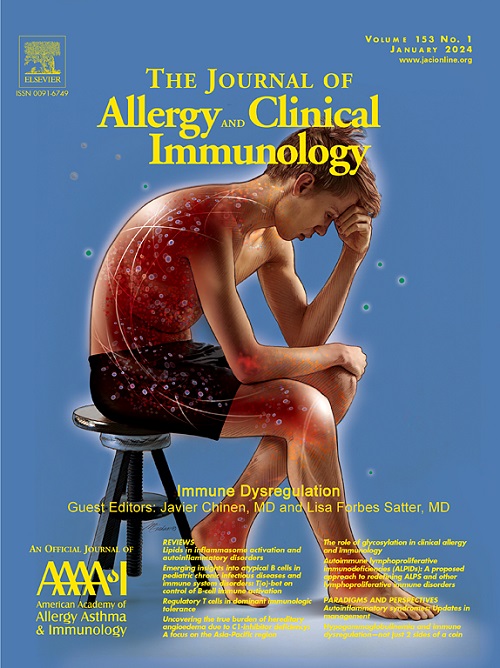嗜酸性食管炎驱使组织成纤维细胞再生程序走向病理功能障碍。
IF 11.4
1区 医学
Q1 ALLERGY
引用次数: 0
摘要
背景:在炎症性、自身免疫性和过敏性疾病中,病理组织重塑伴瘢痕形成和组织僵硬已被证实。嗜酸性粒细胞性食管炎(EoE)是一种通过反复活检诊断和治疗的过敏性疾病,可以了解组织成纤维细胞功能障碍。虽然EoE相关的组织重塑导致临床吞咽困难、食物嵌塞和食管僵硬和狭窄,但导致这些并发症的分子机制仍在研究中。目的:我们假设慢性EoE炎症诱导致病性成纤维细胞组织再生和运动功能障碍。方法:采用单细胞RNA序列分析(scRNA-Seq)、荧光活化细胞分选分析、成纤维细胞分化和迁移实验,分析EoE诱导和保留的致病性功能障碍与健康食管成纤维细胞的差异。结果:分化实验表明,活跃的EoE成纤维细胞保留了对坚硬细胞(如软骨细胞)的再生程序。结论:细胞外ATP处理和CD73紊乱的正常化可以改善2型炎性疾病中致病性成纤维细胞功能障碍和组织再生。本文章由计算机程序翻译,如有差异,请以英文原文为准。

Eosinophilic esophagitis drives tissue fibroblast regenerative programs toward pathologic dysfunction
Background
Pathologic tissue remodeling with scarring and tissue rigidity has been demonstrated in inflammatory, autoimmune, and allergic diseases. Eosinophilic esophagitis (EoE) is an allergic disease that is diagnosed and managed by repeated biopsy procurement, allowing an understanding of tissue fibroblast dysfunction. While EoE-associated tissue remodeling causes clinical dysphagia, food impactions, esophageal rigidity, and strictures, molecular mechanisms driving these complications remain under investigation.
Objective
We hypothesized that chronic EoE inflammation induces pathogenic fibroblasts with dysfunctional tissue regeneration and motility.
Methods
We used single-cell RNA sequencing, fluorescence-activated cell sorting analysis, and fibroblast differentiation and migration assays to decipher the induced and retained pathogenic dysfunctions in EoE versus healthy esophageal fibroblasts.
Results
Differentiation assays demonstrated that active EoE fibroblasts retain regenerative programs for rigid cells such as chondrocytes (P < .05) but lose healthy fibroblast capacity for soft cells such as adipocytes (P < .01), which was reflected in biopsy sample immunostaining (P < .01). EoE, but not healthy, fibroblasts show proinflammatory and prorigidity transcriptional programs on single-cell RNA sequencing. In vivo, regenerative fibroblasts reside in perivascular regions and near the epithelial junction, and during EoE, they have significantly increased migration (P < .01). Flow analysis and functional assays demonstrated that regenerative EoE fibroblasts have decreased surface CD73 expression and activity (both P < .05) compared to healthy controls, indicating aberrant adenosine triphosphate handling. EoE fibroblast dysfunctions were induced in healthy fibroblasts by reducing CD73 activity and rescued in EoE using adenosine repletion.
Conclusion
A normalization of perturbed extracellular adenosine triphosphate handling and CD73 could improve pathogenic fibroblast dysfunction and tissue regeneration in type 2 inflammatory diseases.
求助全文
通过发布文献求助,成功后即可免费获取论文全文。
去求助
来源期刊
CiteScore
25.90
自引率
7.70%
发文量
1302
审稿时长
38 days
期刊介绍:
The Journal of Allergy and Clinical Immunology is a prestigious publication that features groundbreaking research in the fields of Allergy, Asthma, and Immunology. This influential journal publishes high-impact research papers that explore various topics, including asthma, food allergy, allergic rhinitis, atopic dermatitis, primary immune deficiencies, occupational and environmental allergy, and other allergic and immunologic diseases. The articles not only report on clinical trials and mechanistic studies but also provide insights into novel therapies, underlying mechanisms, and important discoveries that contribute to our understanding of these diseases. By sharing this valuable information, the journal aims to enhance the diagnosis and management of patients in the future.

 求助内容:
求助内容: 应助结果提醒方式:
应助结果提醒方式:


